Rath Yatra or in local language referred as Ratha Jatra ( Car Festival of Jagannath ) is an annual Hindu chariot festival. Rath Yatra is celebrated as per Hindu Calender in the month of “Ashadha” (June-July). The festival is celebrated in the city of Puri in the state of Odisha in India. Mahaprabhu “Jagannath” is considered as the “Supreme God” by the Odia community in India and globally.
Jagannath Rath Yatra is mainly celebrated in Puri because mahaprabhu Jagannath stays at Puri in the world famous “Jagannath Temple” with his brother “Balabhadra” and sister “Subhadra”. Also the Rath Yatra is widely celebrated in every parts of Odisha and some parts of India as well as abroad by the devotees of “Jagannath”. Jagannath Rath Yatra attracts almost 4 to 5 lakh pilgrims every year from all over the world.
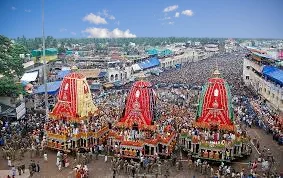
Rath Yatra
For a better clarity let us understand it more clearly. In India, there are many pilgrimage sites and destinations which one should visit and it is believed that a person must visit 4 of these sites in their life once. As per Hindu tradition, it is believed that visiting these sites helps achieve moksha (salvation). These 4 sites or “Char Dham”s are Badrinath, Dwarka, Puri and Rameswaram.
All the ‘dhamas’ are related to four epochs, (1) Dham of Satyuga- Badrinath, Uttarakhand (2) Dham of Tretayuga -Rameswaram, Tamil Nadu (3) Dham of Dwaparayuga – Dvaraka, Gujarat (4) Dham of Kaliyuga – Jagannatha Puri, Odisha. All the 3 Dhamas are of Lord Vishnu except Rameswaram, which is the shrine of Lord Shiva.
So, Jagannath Temple in Puri is one of the Char Dhams in India where the world famous Rath Yatra is celebrated annually. Puri located at the east, is located in the state of Odisha, India. Puri is one of the oldest cities in the eastern part of the country. It is situated on the coast of the Bay of Bengal. The main deity is Shri Krishna, celebrated as Lord Jagannatha. It is the only shrine in India, where goddess, Subhadra, sister of Lord Krishna is worshipped along with her brothers, Lord Jagannatha and Lord Balabhadra. The main temple here is about 1000 years old and constructed by Raja Choda Ganga Deva and Raja Tritiya Ananga Bhima Deva.
Rath Yatra 2023
This year in 2023, the Rath Yatra will be celebrated from 20th june to 28th June.
Rath Yatra Celebrations
The Rath Yatra starts on the second lunar day (dwitiya) the bright fortnight (shukla paksha) of the Hindu month of Ashadha. In Rath Yatra, the three deities leave the temple ( Jagannath Temple ) and go to the Gundicha temple (Gundicha– King Indradyumna’s Queen) to stay their for 7 days and than return to the jagannath temple. One day before the Ratha Yatra, the Gundicha Temple is religiously cleansed for housing the gods.
For three deities 3 huge wooden chariots are prepared by the devotees well in advance and nicely decorated. On the first day of the yatra, the deities are transported in chariots from the main Jagannath temple to Gundicha temple. Lakhs of devotees pull the chariots with their hands and transport the chariots from Jagannath temple to Gundicha temple.
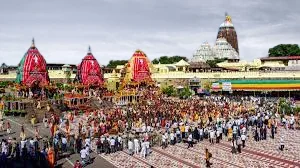
The three chariots involved in the chariot procession are: one for each deity with central chariot called the “Nandighosha”, carrying the main deity of Jagannath and the second chariot known as “Taladhwaja” carrying Balabhadra, and the third chariot called the “Darpadalana” carrying sister Subhadra. The procession progresses down the 3 km long “Bada Danda” (long avenue) and reaches the gates of the Gundicha temple before nightfall. The deities remain in the chariots on the first day and enter the Gundicha Temple on the second day. They reside at the Gundicha temple for the subsequent seven days.
On the way the chariot of Jagannatha, Nandighosa (ନନ୍ଦିଘୋଷ) waits near the crematorium of Bhakta Salabega (ଭକ୍ତ ସାଲବେଗ), a Muslim devotee, to pay him tribute.
On their way back from the Gundicha Temple, the three deities stop for a while near the Mausi Maa Temple (Aunt’s abode) and have an offering of the Poda Pitha, which is a special type of pancake supposed to be the deity’s favourite. After a stay of seven days, the deities return to their abode.
The Ratha Yatra takes one day for traveling to Gundicha temple, deities of lords remain in the temple for seven days, and one day to return home, in total 9 days. This Journey is also known as Gundicha Yatra, Nava Dina Yatra (“nine days Journey”), or Ghosa Yatra.
Bahuda Yatra : 28th June’23.
Bahuda Yatra, the return journey of Lord Jagannath, his elder brother Lord Balabhadra and their sister Devi Subhadra concluded on Wednesday after the deities reached Singhadwar upon completion
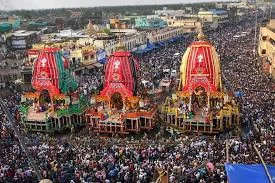
The construction of the chariots starts on Akshaya Tritiya, the third day of the bright fortnight of Vaisakha. This day also marks the beginning of the summer festival of the deities, also known as the sandalwood festival or Chandan Yatra. Carpenters called as Maharana undertake the construction of these chariots, which is their hereditary right since ages.
Rath Yatra Chariot Details
| Chariot Details | Jagannath | Balabhadra | Subhadra |
| Name | Nandighosha | Taladhwaja | Darpadalana |
| Alternates name | Garudadhwaja, Kapidhwaja | Langaladhwaja | Devadalana, Padmadhwaja |
| Wheels | 16 | 14 | 12 |
| Number of wooden pieces | 832 | 763 | 593 |
| Height | 44′ 2″ | 43′ 3″ | 42′ 3″ |
| Length&breadth | 34’6″ x 34’6″ | 33′ x 33′ | 31’6″ x 31’6″ |
| canopies | Red, Yellow | Red, Bluish green | Red, Black |
| (yellow associated with Vishnu) | (Black associated with the Goddess) | ||
| Guardian | Garuda | Vasudeva | Jayadurga |
| Charioteer | Daruka | Matali | Arjuna |
| Flag name | Trailokyamohini | Unnani | Nadambika |
| Flag emblem | |||
| Palm Tree | |||
| Name of Horses | 1. Shankha | 1. Tibra | 1. Rochika |
| 2. Balahaka | 2. Ghora | 2. Mochika | |
| 3. Shweta | 3. Dirghasharma | 3. Jita | |
| 4. Haridashwa | 4. Swarnanava | 4. Aparajita | |
| Colour of Horses | White | Black | Red |
| Name of Chariot Rope | Sankhachuda Nagini | Basuki Naga | Swarnachuda Nagini |
| Accompanying deity | Madanmohan | Ramakrishna | Sudarshana |
| Gatekeepers (Dvarapala) | 1. Jaya | 1. Nanda | 1. Ganga |
| 2. Vijaya | 2. Sunanda | 2. Jamuna | |
| Nine parshvadevata (Subsidiary deities) | 1. Panchamukhi Mahabir (Hanuman) | 1. Ganesha | 1. Chandi |
| 2. Harihara | 2. Kartikeya | 2. Chamunda | |
| 3. Madhusudana (Vishnu) | 3. Sarvamangala | 3. Ugratara | |
| 4. Giridhar (Krishna) | 4. Pralambari (Balarama) | 4. Banadurga (Durga) | |
| 5. Pandu Narasingha | 5. Halayudha (Balarama) | 5. Shulidurga (Durga) | |
| 6. Chitamani Krishna | 6. Mrityunjaya (Shiva) | 6. Varahi | |
| 7. Narayana (Vishnu) | 7. Natamvara (Shiva) | 7. Shyamakali | |
| 8. Chatra Bhanga Rabana (Rama) | 8. Mukteswar (Shiva) | 8. Mangala | |
| 9. Rama seated on Hanuman | 9. Sheshadeva | 9. Vimala |
Suna Besha
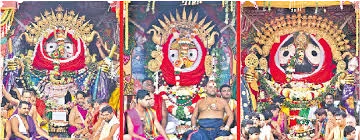
After the deities return to the main temple from Gundicha temple, the three dieties are decorated in gold ornaments and worshipped in the chariot. This ceremony is called as Suna Besha. On this day lakhs of lakhs of people visit Puri to catch a glimpse of this ceremony.
Preparations by Government
A very special arrangement is made every year by the government of Odisha as lakhs pf devotees come to Puri to witness this festival. Starting from traffic restrictions imposed in and around the temple and the city of Puri to necessary security checks for hotels, lodges, guesthouses and the surrounding area of Puri sea beach. Last year in 2022, the festival was celebrated after a long gap of 2 years due to Covid 19 restrictions. The Rath Yatra of 2022 was witnessed by approx 10 Lakhs visitors.
Government and private transport agencies also run special services in this occasion. The Govt. of India also runs special trains to accommodate huge number of passengers.
Suna Besha will be observed on 29th June’23. When queen Gundicha threw open the doors of the mandap, little did she realize that her bout of anxiety will leave the idols of Lord Jagannath, Lord Balabhadra and Devi Subhadra incomplete forever.
Adhara Pana : 30th June’23
Adhara pana is a ritual of offering ‘pana’, a special drink prepared with milk, banana, cheese, aromatic spices and water. As per the practice, it is held atop three chariots of the deities-Nandighosha
Niladri Bije: 01 July 2023
Marking an end to the annual sojourn, Lord Jagannath and His siblings- Lord Balabhadra and Goddess Subhadra return to their abode. This ritual is known as Niladri Bije. But, the day holds an important significance
Interesting Facts about Rath Yatra
Jagannath Puri Rath Yatra is believed to be the oldest religious procession in the world. This annual ceremonial procession marks the beginning of the 9-day long festival. There are various legends associated with the Jagannath Yatra. All involve Lord Jagannath who was an incarnation of Lord Vishnu and his siblings Subhadra and Balabhadra or Balaram.
According to one legend, the Jagannath Yatra symbolizes the journey of Lord Jagannath from Vrindavan to Mathura to slay his evil uncle Kansa. Another legend states that the siblings have just recovered from a severe fever and wish to visit their aunt Gundicha for a celebration. And the third legend states that this is an occasion when Lord Jagannath wants to step out to mingle with his devotees.
The three deities are fashioned with wood, clothes, and raisins, unlike the ornate and carefully crafted metal idols. During the procession, the Raths are accompanied by chants and conches, which can be heard all around. Before the Yatra commences, the idols are bathed with 109 buckets of water, which is Snana Purnima. These are then placed in isolation till the day of procession, as it is believed that they got fever after taking bath. This event is called Ansara.
On the day of the procession, the holy ritual of Chhera Pahara is performed by the royal successor of Odisha. One of the most important duties of Gajapati Maharaja Divyasingha Deva is to perform the iconic ‘Chhera Pahara’ — a ritual involved in this procession, in which the king cleans the three chariots with a golden-handled broom and sandalwood-scented water before the start of the yatra.
Through this ritual, it is proposed that everyone is equal to the Lord Jagannath. The temple is accessible only by Hindus but on the day of the Rath Yatra, people of all faiths can visit the site of Rath Yatra as it is outside of the temple.
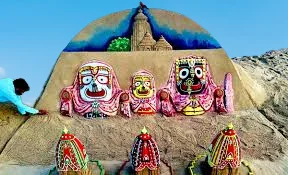
The construction of the chariots starts on the auspicious occasion of Akshaya Tritiya. Approximately 1,400 carpenters are employed every year to build the three chariots. The chariots are constructed without the help of measuring tapes; instead, an ancient technique of measurement is used where hands and fingers are employed to gauge the length and breadth of the vehicles. Moreover, wooden pegs and joints are used instead of metal nails in the creation process.
The tops of the chariots are made in a way that they replicate the structure of the Jagannath Temple towers. A team of 15 skilled tailors make the canopies from 1,200 metres of cloth.
Many devotees who have attended the Rath Yatra have witnessed that Lord Jagannath seems reluctant to move, regardless of how many people are pulling his chariot. After hours of hard work, the rath finally moves, initiating the procession’s forward march.
According to records, there’s not been a single Rath Yatra that didn’t witness heavy downpour. The day of the festival is greeted by rainfall every year (without fail).
The Jagannath temple practices many restrictions on regular days, including one that doesn’t allow anyone other than Hindus to visit the temple. However, on the day of the Rath Yatra, anyone can seek blessings of Lord Jagannath and catch a glimpse of his idol, irrespective of their caste and religion.
The English term ‘juggernaut’ means “a huge, powerful, and overwhelming force.” Drawing inspiration from the gigantic chariot of Lord Jagannath, the British coined this word when they encountered a massive chariot during one Rath Yatra festival.
The day of Basant Panchami marks the beginning of the wood collection for the chariots.
108 pitchers of water are used to ceremonially bathe all the deities. Sahastradhara Snan is the name of it. The well from which the water is used is opened only once a year.
When the chariots get back to the temple, they are disassembled and the wood is used as fuel in the kitchen.
There is a unique tradition in the city of pulling the chariot of goddess Subhadra by women only.
How to reach Puri?
How to reach Puri by Air
The nearest airport is Biju Patnail Airport which is located in Bhubaneswar almost 60 kilometers from Puri. It is quite easy to access Puri as airways are considered as one of the most convenient and hassle free transport services. The airport provide domestic services and you can find major Indian airlines here and regular flights from New Delhi, Kolkata, Visakhapatnam, Nagpur, Hyderabad, Chennai, and Mumbai are operated.
Nearest Airport : Biju Patnaik International Airport, Bhubaneshwar
How to reach Puri by Rail
Puri is a last stop on the East Coast Railway which has direct express and other super fast trains which is well linked with major cities like New Delhi, Mumbai, Kolkata, Okha, Ahmedabad, Tirupati and many more. Some of the famous trains offer direct services to the city which includes Kolkata (Howrah) Puri Howrah Express, Jagannath Express; New Delhi Purushottam Express.
How to reach Puri by Road
Roadways is another one of the most appropriate option to reach Puri as the nearest bus stand is located close to the Gundicha Temple which provides direct connections to Bhubaneswar and Cuttack and one can reach the place in just 10 to 15 minutes. Bhubaneswar is located at a distance of almost 50 km from the city while Jamshedpur at 333.9 km, Visakhapatnam at 355.1 km, Ranchi at 396.3 km and Calcutta at 403.7 km are few important cities that can be visited from Puri if you have a lot of time.
Places to visit in Puri
If you are visiting Puri, plan in such a way that you can cover and explore the below sights.
Jagannath Temple, Gundicha temple, Golden beach, Puri Beach, Swargadwara Beach, Sudarshan Crafts museum, Konark Sun temple, Chilika lake. On the way to Konark, there are many water parks also available. Also please note that, every year the renowned international sand artist from Odisha, Padma Shri Mr. Sudarsan Pattnaik display different sand sculptors in the sea beach of Puri.